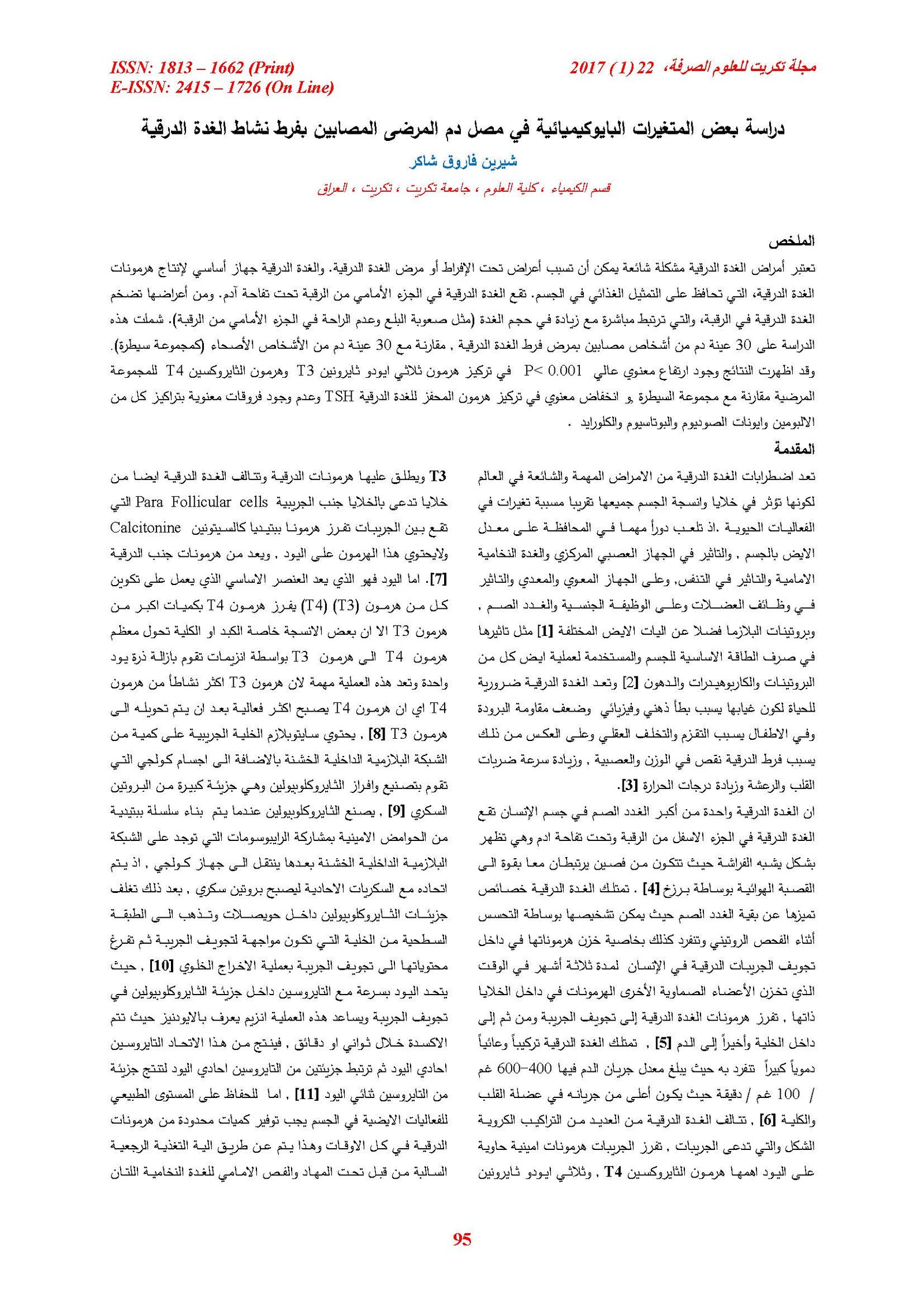Study of some biochemical parameters in blood serum of hyperthyroidism patients
Main Article Content
Abstract
The Thyroid disease is a common problem that can cause symptoms because of over- or under-function of the thyroid gland. The thyroid gland is an essential organ for producing thyroid hormones, which maintain the body metabolism. The thyroid gland is located in the front of the neck below Adam's apple. Thyroid disease can also lead to enlargement of the thyroid gland in the neck, which can cause symptoms that are directly related to the increase in size of the organ (such as difficulty in swallowing and discomfort in front of the neck). This study included30 blood samples from Patients with Hyperthyroidism, compared with 30 blood samples from healthy people as a control. The results showed the presence of high-rise significantly in the concentration of the hormone T3 hormone T4 In Patients group's compared with the control group, while there was a significant decrease in the concentration of TSH and no significant differences in concentrations of both albumin sodium, potassium and chloride ions
Article Details

This work is licensed under a Creative Commons Attribution 4.0 International License.
Tikrit Journal of Pure Science is licensed under the Creative Commons Attribution 4.0 International License, which allows users to copy, create extracts, abstracts, and new works from the article, alter and revise the article, and make commercial use of the article (including reuse and/or resale of the article by commercial entities), provided the user gives appropriate credit (with a link to the formal publication through the relevant DOI), provides a link to the license, indicates if changes were made, and the licensor is not represented as endorsing the use made of the work. The authors hold the copyright for their published work on the Tikrit J. Pure Sci. website, while Tikrit J. Pure Sci. is responsible for appreciate citation of their work, which is released under CC-BY-4.0, enabling the unrestricted use, distribution, and reproduction of an article in any medium, provided that the original work is properly cited.
References
1. Chandramouli, R.(2009). Textbook of physiology. 2nd ed . Jaypee Brothers Pub. New Delhi.pp;316-321. 2. Cown, A; and Newlands, S. (2006). Benign thyroid disease . Univesity of Texas Medical branch .pp;13 3. Skarulis MC, Stack BC Jr(2015). Thyroid disease. e-Publication; Office on Women's Health (OWH). U.S. Department of Health and Human Services, Washington DC. pp;16-18 4. Albasri A, Sawaf Z, Hussainy AS, Alhujaily A (2014). Histopathological patterns of thyroid disease in Al-Madinah region of Saud i Arabia. Asian Pac. J. Cancer Prev. 15:5565-5570.. 5. Ratini M (2015). Understanding Thyroid Problems- the Basics: Women's Health. WebMD Medical Reference, WebMD, LLC. 6. Dietrich, J.W.; and Brisceauund, B.O. (2008) .Absorption, Transport and Bioavailbility of iodothyronines. 133(31/21)1644-8 7. Vanderpump M (2013). The epidemiology of thyroid disease. Br. Med. Bull. 99:39-51. PMID: 5673172 8. Le Fevre, ML (2015). "Screening for Thyroid Dysfunction: U.S. Preventive Services Task Force Recommendation Statement.". Annals of internal medicine. pp;133 9. Davies, T. F. (2015). Pathogenesis of hashimoto’s thyroiditis (chronic autoimmune thyroiditis). Retrieved from 10. Caturegli, P., De Remigis, A., Chuang, K., Dembele, M., Iwama, A., & Iwama, S. (2013). Hashimoto’s thyroiditis: Celebrating the centennial through the lens of the Johns Hopkins hospital surgical pathology records. American Thyroid Association, 23(2), 142-150. 11. Eroschenko, V.P. (2010). Di fiore ,s atlas of histology with functional correlation.10th ed.
Lippincott Williams 12. Fazio, S.; Palmieri, A. E.; Lombardi, and Biondi, B. (2009) Effect of thyroid hormone on the cardiovascular system. The endocrine society. pp: 31-50 13. Chiasera, J. M. (2013). Back to the basics: Thyroid gland structure, function and pathology. Clinical Laboratory Science, 26 (2), 112-117 14. Mendes, A. (2015). Recognizing hypothyroidism in the community: What can nurses and patients do? British Journal Community Nursing, 20(4), 200-202. 15. Doumas, B.T.; Watson, W.A. and Briggsh, H.G. (1971). Albumin standards and measurent of serum albumin with bromocresol green in Clin. Chem. Acta, 31.
16. Young DS. (1995), Effects of drugs on clinical lab Tests , 4th ed. AACC, Washington, Press.
17. Tietz. N.W. Clinical Guide to Laboratory tests ,3rd Edition .W.B. Saunders Co Philadelphia, PA. (1995).
18. Uotila, M.; Ruoslahti, E. and Engvall , E. (1981). J. Immunol .Methods . 42: 11 – 15 .
19. Cheng ،SY؛ Leonard, JL؛ Davis, PJ (Apr 2010). "Molecular aspects of thyroid hormone actions". Endocrine Reviews 31 (2): 139–70. doi: 10.1210/er.2009-0007.PMC 2852208. PMID 20051527. 20. Andreas Shuld , “How Do Flouride Interfere with thyroid Hormones ?”(2010);15:32:18 . Canada . 21.Zao, W.; Zhu, H.; et al. “Long – Term effects of various iodine and fluorine doses on the thyroid and fluorosis in mice“. Endocrine. Regulations. (2011); 32:63-70 .
22. Negro R, Stagnaro - Green A؛ Stagnaro-Green (2014). "Diagnosis and management of subclinical hypothyroidism in women". BMJ 349 (10): pp;1 23.Farer, L.S.; Robbins, B.S. ;et al. “Thyroxine – serm protein complexes invarious animals.” Endocrinology. (2000):70:686-696 24.Hampton, J. (2013). Thyroid gland disorder emergencies: Thyroid storm and myxedema coma. AACN Advanced Critical Care, 24(3), 325-332. 25.Brown, RS (2013). "Autoimmune thyroiditis in childhood". Journal of Clinical Research in Pediatric Endocrinology (Review). 5 Suppl 1 (4): 45. 26.Dennis L. Kasper; Anthony S. Fauci; Stephen L. Hauser; Dan L. Longo; J. Larry Jameson; Joseph Loscalzo (2015). Harrison's principles of internal medicine. New York: McGraw-Hill Medical Publishing Division. وا حة 2289. ISBN 0-07-180215-0 27.Martinez-Triguero, ML.; Hernandez - Mijares, A; Nguyen and TT., (2012): Effect Of Thyroid Hormones Replacement on Lipoprotein (a), lipids and apolipoproteins in subjects with hypothyroidism. Mayo. Clin. Proc., vol.73, pp.837-841.
